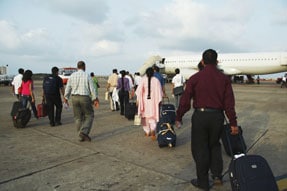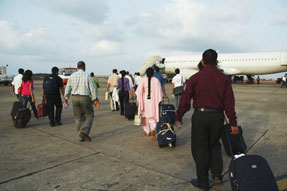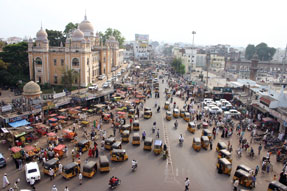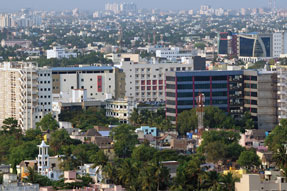Magazine
India Calling

Second generation Indian Americans turn to India for professional opportunities.
| Sapna Chadha has a daily ritual: After returning home from work and eating the dinner prepared by her live-in help, she calls her parents in Montville, N.J. Nothing too unusual there, except that Chadha is phoning from India, the land of her parents’ birth, 10.5 hours ahead of New Jersey time. And though the family doesn’t always have a lot to talk about, the calls are important. For her parents, it makes the distance bearable. For Chadha, it eases the guilt of being so far away.
More than three decades after they left India, Chadha’s parents never imagined their youngest daughter would reroute that course and return to their homeland. It seemed inconceivable that their “fully American daughters,” as their father describes them, both born and raised in New Jersey, would want to live in India.
But that is exactly what Chadha, 34, decided to do in September 2008, a couple of months after getting married. Her husband, born and raised in India, but who had spent more than 20 years in the U.S., was recruited to help start up a software development company in New Delhi. In New York City, where they lived before their move, they owned two apartments and drove a brand new Mercedes Benz. And yet, Chadha, a young executive at the American Express headquarters in New York, was thrilled when her husband’s work offered the opportunity to move to India. She recognized it as a career opportunity for her, too — especially after spotting a billboard in India a few years earlier promoting the American Express Platinum card, an exclusive service for high-net individuals. Seeing the ad then, it dawned on her that working in India would help bump her career up to the next level. “Growth is not coming from the U.S. It’s coming from other places, smaller markets,” said Chadha. “The experience you get working in a small market and what you’re responsible for is 100 times more.” In the 20th century, global immigration patterns were marked by the flow of people from less affluent areas of the world to more affluent ones, from the south and east (Africa, Asia and South America) to countries in the industrialized north and west (North America and Europe). Today, thanks to globalization and emerging economies, the tide may be shifting. Some of the very immigrants who once waited anxiously for the rubber stamp of approval to enter the places they perceived would provide them with better opportunities and greater freedoms are returning back to their countries of origin. Even more surprisingly, the adult children of immigrants, who have lived most if not all of their lives abroad in the U.S. and Europe, are defying expectations and choosing to immigrate to the places their parents left. Indian and Chinese Americans are at the forefront of this phenomenon.
For a certain class of people, upper and middle class, it is easy to reconstruct their lifestyle anywhere, says Peggy Levitt, a Wellesley College sociologist who studies immigration and transnationalism. She says the backdrop of cosmopolitanism and the growing trend toward global careers are some of the reasons it has become desirable and easier for young professionals to move to their parents’ countries of origin. “They can be in India but live like they’re in New York or London,” she said. This mobility combined with a television- and internet-fueled global youth culture has allowed more fluidity in how people negotiate their identity. Levitt says people today, especially younger generations, feel less constrained by their place of birth. For Chadha, the summers she spent in India as a child and the traditions her family brought with them to the U.S. helped her adjust to her new home. She remembers always being proud of her cultural heritage. “When every kid in my class brought cupcakes for their birthday, I would insist on Indian sweets,” she said. “I didn’t mind standing out.” Now, living in New Delhi, for the first time in her life, Chadha is surrounded by people who look like her. The similarity ends when she speaks, though. She draws out her words with a distinct American cadence and is apt to use slang that you are more likely to hear on the streets of New York than New Delhi. She says notwithstanding the strong affinity she has for India, there is quite a bit about living there that makes her feel alien. For instance, although she secured her new position as the marketing director of American Express without much difficulty, she says, the workplace culture in India has taken some getting used to. “There’s a lot of yelling and reprimanding that happens here,” she says. “People react when you yell and then it’s like oh she’s serious, I have to get my work done.” She is also troubled by the fact that most hires are based on connections and not merit. Chadha’s extended family and her husband help her navigate cultural differences that she’s not equipped to handle. She also leans on them for language support. While she can understand much of what she hears, Chadha does not speak Hindi fluently. “If I’m shopping alone, I’ll put my husband on speaker phone, and he does the talking,” she said.
It’s not always easy for Chadha’s parents to understand why she’s drawn to India. They ask, how can she live in a place with so many hardships? Why would she forego the comforts and amenities that are customary in the West? “I almost feel guilty saying I’m having a good time,” Chadha says of her conversations with her parents. Her 73-year-old father, Naresh Chadha, has no interest in doing what his daughter has done. “If I go back to India, I’ll be a stranger,” he said, in a telephone interview from New Jersey. But he concedes that his daughter is more adaptable and that the move is probably very good for her career. “We’re fine with her being there, as long as she comes back in three to four years,” he said. Historically, immigration was seen as following a linear course that ended with one final destination. People left their countries of origin with the vision of better lives in other parts of the world and once they reached their destination, their resettlement was permanent. But human migration has always been more dynamic than its narrative, changing with the times. While there is nothing new about return immigration, researchers say that there is a fundamental difference in the motivation of those who return today versus returnees of the past. Earlier, people went back to their home countries because of disillusionment with the new country, notably because of discrimination and other obstacles they faced. Now, armed with the belief that they will find success and a quicker and perhaps easier path to it, returnees are packing their bags to take advantage of burgeoning economies that hold promise for fulfilling their dreams. What’s more, returnees today are high-skilled professionals whose collective contributions could have a major influence on the economies of developing countries. Some researchers even believe that the new trend could help reverse brain drain — a concept that describes a dearth in human capital due to the mass emigration of highly-skilled individuals from developing to developed economies. According to a study published by the Ewing Marion Kauffman Foundation in March 2009, “Since even before the 2008 financial and economic crisis, some observers have noted that a substantial number of highly skilled immigrants have started returning to their home countries, including persons from low-income countries like India and China who have historically tended to stay permanently in the United States.” Vivek Wadhwa, professor at Duke University’s Pratt School of Engineering and Harvard Law School’s Labor and Worklife Program surveyed 1,200 Chinese and Indian high-skilled immigrants for the Kauffman Foundation report. He found that on average returnees were professionals in their mid-30s with graduate degrees and successful careers in the United States. “Young people are more ambitious and willing to take a risk and for the majority we spoke to, the risk had paid off with even more successful careers back in their countries,” he said. While there are no hard numbers on exactly how many people are returning back to the home country, Wadwha and other researchers believe it is significant. According to a report by the Migration Policy Institute, a Washington, D.C.-based nonprofit think tank that studies immigration trends around the world, of the 10.6 million people that immigrated to the United States in the 1990s, more than 20 percent did not end up staying in the country. The report points to a similar trend in Canada where a study found that 35 percent of young working-age male immigrants returned to their home country within 20 years of their arrival in Canada. Immigration and international development experts stress that returnees today may be harbingers of what is to come. Most first generation immigrants (those who come to the U.S. for short stints as students or H1-B visa holders) return to be close to their families or because they are nostalgic for what they left behind. But the impetus, especially for the second generation to return to their parental homeland, is the prospect of career advancement or simply a new experience.
According to a recent study by the World Economic Forum and the Boston Consulting Group, 32,000 second generation Indians from the U.S. and Europe immigrated to India in 2006. Sonali Jain, a postdoctoral associate at Duke University, conducted in-depth interviews with 48 second generation Indian Americans living in India. She writes: “All respondents asserted that the availability of exciting professional career pathways in India was an important factor in influencing their ‘return’ migration decisions. Respondents observed that in India they worked in the middle to upper echelons of management. Many pointed out that they held positions that would have taken them five or more years to achieve in the United States because such opportunities were simply unavailable to persons of their age and work experience.” Bimal Jha, who asked that his real name not be used, was like many young professionals living in New York. He worked hard and put in long hours at a Wall Street hedge fund because he believed in the immediate and long-term payoff of his sacrifice. He lived well in one of the most expensive cities in the world and believed that he had a bright future ahead of him. But working more than 15 hour days, starting well before the sun rose, he said he was tired and increasingly unhappy in the cutthroat world of finance. He began to question his future and whether he should continue to toil at a job that was becoming less and less gratifying. Around the same time, an uncle in India started to woo him for a position at the metal manufacturing company he had established in Bangalore, India. This uncle, who himself had left the U.S. to start the company, encouraged Jha to enroll in business school and when he finished he would have a job waiting for him. Heeding that advice, Jha quit his trading job and began attending the Rutgers University Business School. Just five months later the financial crisis hit and Wall Street as he knew it began to crumble. “My friends and former bosses were all getting fired,” he said. When entering business school, Jha says, he wasn’t completely sold on the idea of moving to India, but after the financial meltdown, he began to seriously consider taking his uncle up on his offer. Meeting his now fiancée in business school, also an Indian American, and who like him was thinking about working in India after graduation, sweetened the prospect of moving to India. For Jha, nostalgia or even a desire to live in the country that he left when he was five months old did not figure into his decision to emigrate to India. “I’m not a little American, I’m very American,” he said in describing himself. Moving to India was solely a professional decision. “I didn’t like my choices at home,” he said by phone from Bangalore. “I imagined the jobs I was applying for (in the U.S.) and knew with any job I would get out of business school, it would take years to get to the point where my job would be interesting.” Adding that he didn’t want to go back to being miserable for the sake of some uncertain future happiness, he became firm in his decision to move to India. Jha, who arrived in India in September 2010, now holds a senior level position and gets to flex his skills in ways he’s never been able to before, negotiating deals with the likes of NASA.
Little research exists on the impact that people like Chadha and Jha have on their new homes. Nonetheless, return migrants are being welcomed back with open arms because they are seen as antidotes to the talent scarcity that plagues many developing nations, in part thanks to the flight of their brightest over the decades. According to a 2005 report by the Migration Policy Institute “between a third and half of the developing world’s science and technology personnel now live outside the developing world.” But not everyone agrees that brain drain is necessarily a bad thing. Dhananjayan Sriskandarajah, director general of the Royal Commonwealth Society, a London based education organization, has researched the impact of immigration on developing countries. In the 2005 Migration Policy Institute report he writes: “While it is easy to identify the ways in which brain drain can hurt economic development, the reasons that it may not be so bad, or may in fact be positive, are not so obvious. Yet, acknowledging and accounting for the positive spin-offs from highly skilled emigration is an important first step in getting to the bottom of the dilemmas brain drain poses.” He and other academics believe that the prospect of immigration can have a positive impact and give people an incentive to acquire the skills necessary for them to pursue opportunities overseas. These skills, they claim, by raising standards, can help in the development process. They also argue that once these individuals leave, all is not lost, because they often send money home. That money is used amongst other things to cover school fees of family members and education is an important agent in helping a family’s break from poverty. Moreover, the brain drain from the departure of high-skilled individuals may be temporary. According to Survey of Earned Doctorates (SED), 26% of doctoral candidates graduating in 2008 planned to return to their home country. Yet the Diaspora is being courted like never before.Governments around the world — from the poorest countries to those who have a long history of relying on the money sent by their nationals living abroad — are passing laws and launching programs that make return easier and more appealing for their Diaspora. Tarhun Khanna, author of the book Billions of Entrepreneurs: How China and India are Shaping Their Futures and Yours, writes, “Historically Indians leaving the country were chastised as having crossed kaala paani, or black water, and were therefore impure.” He explains that the Indian government was compelled to rethink this point of view when it was hit with a financial crisis in 1991 and was forced to turn to the Indian Diaspora for capital.
Since then the Indian government has steadily created programs and incentives to facilitate the return of overseas Indians. In addition to establishing the Ministry of Overseas Indian Affairs in 2004, the Indian government also established legal residency cards, such as the Person of India Origin (PIO) Card and Overseas Citizen of India (OCI) Card, for overseas Indians making it easier for them to live and work in India. India is not the only country intent on finding and bringing back the talent it lost to immigration. The Chinese government has sought to scale up certain industries, for example, by actively recruiting Chinese American professionals in the science and technology sectors to fill positions it views critical for China’s growth. Some of the poorest developing countries, such as Ethiopia, have launched similar programs. However, it may be easier for the Chinese and Indian governments to entice the Diaspora because of their status as the largest and most stable emerging economies, though emerging is quickly becoming a misnomer especially in the case of China. Because the two countries have the conditions and the financial infrastructure necessary to compete in the global market, there has been an upsurge of foreign investment in the country, including human capital from the Diaspora. Had the Indian economy not shown robust growth potential, Abhijit Das may not have moved to India. He also had a 93-year-old grandfather he wanted to be close to. But he admits that it would have been harder, maybe even unimaginable, for him to give up his plush job working as a lawyer in Boston, were it not for what appeared to be India’s endless possibilities. “I had everything, but I got really bored,” said Das about what ultimately led him to move to India in 2006 after being recruited by Molinaro Koger, a hotel real estate advising firm, to launch its business in India. Das arrived in Mumbai with high hopes for himself, but found many roadblocks, such as rampant corruption and infrastructural problems, that he did not anticipate. Das, 37, says he didn’t actually start to enjoy India until some 10 years ago when he was finally able to experience it for himself as an adult. “I could finally look at it (India) not just from the lens my parents put on it,” he said. Laughing, he adds, “It was eye opening to discover that not everyone in India is good.” Despite his disappointments with the business climate in India and having to renege on his original plans, Das wanted to stay in India. He took another job as senior director of development for Hilton Hotels India and while initially expecting that his move would only be for two, maybe three years, he has now been in India for the past five years.
Recognizing the value of overseas Indians to the development of the country, the Indian government continues to court the Diaspora. During his official visit to the United States in 2009, Indian Prime Minister Manmohan Singh encouraged Indian Americans to return and work in India. Indian businesses are also starting to look abroad to get the competitive edge they need to grow in the global market. But not everyone is returning to India to make money. Nisha Gupta, born and raised in Bowling Green, Ohio, is one of many Indian Americans who have gone back to India because she wanted to make a humanitarian contribution to the country. She wasn’t returning to capitalize on India’s economic ascension, but rather because of a desire to help those living under the grips of extreme poverty, which is still the vast majority of the Indian population. Growing up, every two to three years, her family would visit relatives in India. Gupta said it was on those visits that her lifelong obsession with India started. She credits her parents for helping to bridge her Indian and American identities without being heavy-handed about it. “Other parents were shoving India down their kid’s throats and it backfired,” Gupta explained. Today, fluent in Hindi, Gupta says she and her sisters picked up the language from watching Bollywood films. In 2003, Gupta, 34, started to actively look for a transfer to India from her post at the Center for Disease Control (CDC), a U.S. government agency, headquartered in Atlanta, Ga. In 2004, Gupta, a behavioral scientist, moved to Chennai, after receiving an offer to work there as an international health practitioner with the CDC. She and her American husband lived there for four years before moving to Vietnam, where she currently resides. Ultimately, Gupta says, it was the visceral connection she felt to the country that lured her there. “There is a different level of familiarity and passion I have for India. I always wanted to go back,” said Gupta. “I wanted to make a difference there before anywhere else.” But Gupta’s parents, like others interviewed for this article, were not entirely happy with her move to India. Gupta says her parents were traumatized and always asked about things like the water and electricity supply and how she’s faring with the unreliable access to basic essentials. Although Gupta says she was prepared for everything, she has had a difficult time adjusting to some changes, like unreasonable bureaucratic holdups and having other people take care of her personal chores. “You have other people wash your clothes and do things you would normally do yourself because no one really has a washing machine there. I have a whole new appreciation for the basic things back home, all the things I took for granted.” All in all, though, Gupta says her time in India was one of the most fulfilling of her life. She and her husband are now thinking about having children. “I would love to raise them in India. I want them to feel a connection to it like I do,” she said. A connection to the subcontinent is exactly what Indicorps, a public service program similar to Americorps, wants to help instill in Indians living abroad. Founded in 2001, Indicorps has had 150 fellows from the United States and Europe go through its programs. Fellows work on development and grassroots projects, such as ones that promote leadership development in disenfranchised youth or in rural health clinics. Tanya Sehgal, 26, a former Indicorps fellow and currently a student at Columbia University Law School in New York, was like many who apply for the program — a recent college graduate, seeking to get international experience and connect to her ancestral roots. Born and raised in New Jersey, what she knew of India came from watching Bollywood movies and going there to attend lavish weddings. “I didn’t really know India, I definitely had no idea how the majority of Indians lived.” Sehgal was assigned to work in Bhopal, a city in central India, where she was tasked with developing an English language curriculum for a local school in a rural area. Over the phone last spring, speaking quickly and excitedly, she said, “In India there is more room to be creative; it’s a transformative space.” She said there is a hunger for innovation in India and the opportunity to get involved in projects that make a difference in people’s lives. “In the U.S., I would have ended up working as a research assistant or something, which would just mean pushing paper,” she said. “That just didn’t interest me.” Sehgal says she will find a way back to India and when asked if she could see herself living in India, without hesitation, she yells affirmatively over the phone. But, she adds, that she would have to find the right kind of job. Meanwhile, Chadha who has now been living in India for 18 months thinks that she may have experienced greater professional growth had she stayed in the U.S. “I’m getting more experience, in new sectors and my job is bigger.” she writes from India, “I might have been closer to being a vice president if I had stayed in the U.S.” But Chadha is clear that India is a temporary home and says she and her husband will only stay a couple more years. “We definitely don’t intend to be here forever.” Exactly what her parents would love to hear.
|







